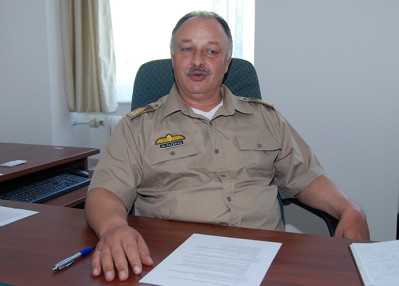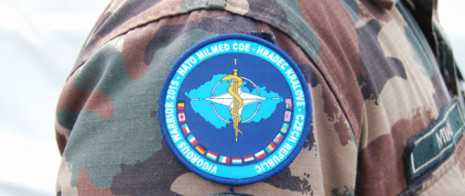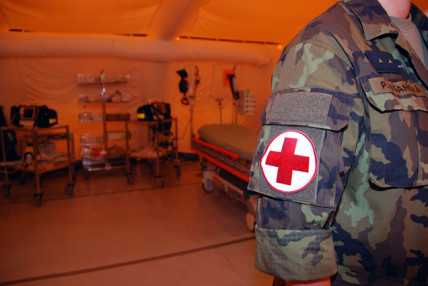Knowledge Hub and Knowledge Management
Szöveg: László Szűcs | 2016. október 9. 9:02The NATO Centre of Excellence for Military Medicine – the medical “citadel” of the Hungarian Defence Forces – is housed in the Róbert Károly Krt. premises of the Military Hospital in Budapest. Col. (MD) Dr. László Fazekas was appointed the new director of the organization in mid-July. We interviewed him about the plans of the Centre of Excellence.
Active role in the establishment of the Centre
Col. (MD) Dr. László Fazekas took over command of the Centre as its new director from his German colleague Brig.-Gen. Dr. Stefan Kowitz on 14 July 2016, but he had already worked in the organization before, as its deputy director and chief of staff for three years. Furthermore, in 2008 he already played an active role in establishing the Centre. Since its establishment, Col. Fazekas has been the third director of the MILMED COE (the first being Brig.-Gen. István Kopcsó), and this position is filled by Germans and Hungarians in turns.

“Quite frankly, when I first heard the name of this Centre translated into Hungarian, I found it very strange. If it had been up to me, I would have translated the English expression as “tudásközpont" (knowledge hub), because in fact all NATO Centres of Excellence are knowledge hubs that specialize in a given functional area. In Hungary, this functional area is military medicine. Apart from ours, there are 23 other centres of excellence in NATO. At the 2002 Prague Summit, it was decided that the framework nations should establish such centres, and accordingly, these organizations were set up to bridge the gaps in certain areas, which enabled the Alliance to respond to the challenges and issues of the age", Col. Dr. László Fazekas told us.
The director added that the centres of excellence, including the MILMED COE, have been operating independent of NATO’s everyday mission-related and other tasks. They analyze, assess, filter and publish the huge amount of information coming in from their functional areas. “This is called knowledge management. In today’s world, anyone can access a huge amount of information that is almost unmanageable and impossible to process. We, and the other centres of excellence, are here to do this job – so we can say what items the subject matter experts working in their functional areas can use out of this “information tsunami", the colonel told us.

These lessons learned are available to everyone on the website of the NATO MILMED COE. At present, more than 600 such observations can be downloaded from the website, where the visitors can also find the 74 medical standardization documents (STANAGs) used in NATO.
“Vigorous Warriors"
The other main area of activity of the NATO Centre of Excellence for Military Medicine is education and training. The greatest result in this field is the exercise series Vigorous Warrior, to be organized every second year. “This exercise is the most complex form of collective training, which had been unprecedented in NATO until 2011. In that year, the MILMED COE organized the first iteration of this training event in Hungary", Col. Fazekas told us, adding that the exercise was hosted by Germany in 2013 and by the Czech Republic in 2015. On the first occasion, the training audience comprised the representatives of five nations. In 2013, the exercise took place with the participation of experts in military medicine from 11 countries, and last year 16 participating nations were registered.

So far, experts from 20 nations have notified us of their intention to participate in Exercise Vigorous Warrior 2017, to be conducted in Germany again next year. It is interesting that participants will arrive not only from Europe but also from New Zealand, for example. The exercise is scheduled to run on the Lehnin military training grounds, near Berlin, and will focus on further training for defence activities in a biological environment, which had already started during last year’s event in the Czech Republic. The only difference will be that the tasks of the 2015 exercise were based on a Non-Article 5 (i.e. foreign mission) scenario, whereas we are planning to hold the next iteration of the exercise in 2017 under a scenario based on “collective defence", during which we are going to practice how to provide medical support for defensive operations", László Fazekas emphasized, and went on saying that because the NATO Non-Article 5 operations are conducted in non-static environments (in contrast to force health protection on foreign missions), the participants of the 2017 exercise will conduct maneuvers with a field hospital as well, just like it would happen in real life. “This means that the medical staff sets up the hospital, reaches full operational capability, and receives the imitated wounded for treatment. In what follows, a movement order is issued, so the staff packs up and redeploys to another site where they start over everything", the director informed us.
“This is a huge task, and that’s why it requires training. In recent years, we have not been on the move with our deployed field hospitals. At the same time, a state-of-the-art ROLE-2 or ROLE-3 level hospital cannot operate without CT scanners, but there are pre-set parameters for moving this kind of equipment – including the methods for packaging and transportation – so we must practice this too", the colonel said, adding that the objective of the Vigorous Warrior exercises is to enable medical experts to smoothly cooperate and save lives in NATO-led missions or other tasks. “Under a fundamental directive in the Alliance, we have to »minimize morbidity and mortality among deployed forces«, so we cannot make any mistakes in our work because that would cost lives", emphasized László Fazekas.

More than a hundred projects per year
Of course, besides preparing for Exercise Vigorous Warrior 2017, the NATO Centre of Excellence for Military Medicine has several other tasks. According to the director, the personnel carry out more than a hundred projects each year, and do their best to achieve that new nations join the Centre. Currently, negotiations are under way with two nations, so it is expected that in a short time, the United States of America and Slovakia will join the nine present member states, i.e. Belgium, the Czech Republic, the United Kingdom, France, the Netherlands, Germany, Italy, Romania and Hungary.
The colonel told us that it is also natural that the staff of the NATO MILMED COE maintain “a very good relationship" with the medical experts of the Hungarian Defence Forces, which is further facilitated by the fact that the Centre of Excellence operates in the Róbert Károly krt. premises of the HDF Medical Centre. “We are in daily contact with the Hungarian colleagues, who regularly participate in further vocational training courses and programs organized by the Centre", the director told us.

Col. (MD) Dr. László Fazekas attended the Nyíregyháza Military College between 1980 and 1984, and then received education as a military physician at the Kirov Military Medical Academy in Saint Petersburg, Russia. As chief medical officer, he was first posted to the Vay Ádám Logistic Battalion in Nyíregyháza in 1991. After the disbandment of the unit in 2001, as a chief physician he was transferred to the Medical Directorate of the Land Forces Command in Székesfehérvár, and subsequently became brigade surgeon and the commander of the medical centre of the HDF 5th Bocskai István Mechanized Infantry Brigade in Debrecen. Between 2005 and 2008, he served as medical officer (physician), Deputy MEDAD at HQ NATO Joint Force Command South, Naples, Italy. In September 2008, he was appointed training branch chief of the NATO MILMED COE. Between 16 December 2013 and 13 July 2016, he was deputy director and chief of staff of the Centre, and has been its director since 14 July 2016. He obtained specialization as General Practitioner at the Debrecen Medical University in 1997. He has “C" type certificates of advanced language proficiency in English and Russian. He is married and has two sons.
Photos by the author and archives